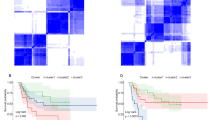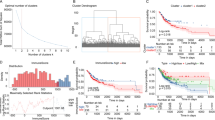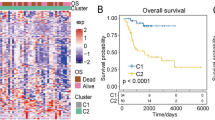Abstract
Background
Glycolysis and tumor immunity were interrelated. In present study, we aimed to construct a prognostic model based on glycolysis-immune-related genes (GIGs) of osteosarcoma (OS) patients.
Methods
The mRNA expression data of OS patients were downloaded from GEO and TARGET databases. The hub genes were screened from 305 differentially expressed genes by univariate cox regression analysis and used to further establish a prognostic Risk Score. The independence of the Risk Score prognostic prediction model based on five genes was tested by multivariate Cox regression analysis. Finally, CIBERSORT and LM22 feature matrix were used to estimate the differences in immune infiltration of OS patients.
Results
A total of 141 OS patients’ mRNA expression data and 296 glycolysis-associated genes were analyzed. Based on these 296 genes, all patients could be divided into two clusters: high glycolysis state and low glycolysis state. In the group with high glycolysis status, patients had low immune scores, indicating that glycolysis status was negatively correlated with immune function. The OS patients with high glycolysis and low immunity had the worst prognosis. Next, the Risk Score was constructed by 5 GIGs, including RAI14, MAF, CLEC5A, TIAL1 and CENPJ. Moreover, the Risk Score was shown to be an independent prognostic model, and high Risk Score patients had a greater risk of death.
Conclusions
The Risk Score based on GIG could predict the prognosis of OS patients.







Similar content being viewed by others
Availability of data and materials:
The datasets generated and analyzed during the current study are available in the Gene Expression Omnibus (GEO, https://www.ncbi.nlm.nih.gov/geo/) repository and the Therapeutically Applicable Research to Generate Effective Treatments (TARGET, https://ocg.cancer.gov/programs/target) repository.
References
Ren C, Liu J, Zheng B, Yan P, Sun Y, Yue B (2019) The circular RNA circ-ITCH acts as a tumour suppressor in osteosarcoma via regulating miR-22. Artif Cells Nanomed Biotechnol 47:3359–3367. http://doi.org.10.1080/21691401.2019.1649273
He M, Shen P, Qiu C, Wang J (2019) miR-627-3p inhibits osteosarcoma cell proliferation and metastasis by targeting PTN. Aging (Albany NY) 11:5744–5756. http://doi.org.10.18632/aging.102157
Huang C, Wang Q, Ma S, Sun Y, Vadamootoo AS, Jin C (2019) A four serum-miRNA panel serves as a potential diagnostic biomarker of osteosarcoma. Int J Clin Oncol 24:976–982. http://doi.org.10.1007/s10147-019-01433-x
Lv S, Guan M (2018) miRNA-1284, a regulator of HMGB1, inhibits cell proliferation and migration in osteosarcoma. Biosci Rep 38:http://doi.org.10.1042/BSR20171675
Warburg O (1956) On the origin of cancer cells. Science 123:309–314. http://doi.org.10.1126/science.123.3191.309
Teicher BA, Linehan WM, Helman LJ (2012) Targeting cancer metabolism. Clin Cancer Res 18:5537–5545. http://doi.org.10.1158/1078-0432.CCR-12-2587
Vander Heiden MG, Cantley LC, Thompson CB (2009) Understanding the Warburg effect: the metabolic requirements of cell proliferation. Science 324:1029–1033. http://doi.org.10.1126/science.1160809
Wan J, Liu Y, Long F, Tian J, Zhang C (2021) circPVT1 promotes osteosarcoma glycolysis and metastasis by sponging miR-423-5p to activate Wnt5a/Ror2 signaling. Cancer Sci 112:1707–1722. http://doi.org.10.1111/cas.14787
Han X, Yang Y, Sun Y, Qin L, Yang Y (2018) LncRNA TUG1 affects cell viability by regulating glycolysis in osteosarcoma cells. Gene 674:87–92. http://doi.org.10.1016/j.gene.2018.06.085
Sottnik JL, Lori JC, Rose BJ, Thamm DH (2011) Glycolysis inhibition by 2-deoxy-D-glucose reverts the metastatic phenotype in vitro and in vivo. Clin Exp Metastasis 28:865–875. http://doi.org.10.1007/s10585-011-9417-5
Jiang Z, Liu Z, Li M, Chen C, Wang X (2019) Increased glycolysis correlates with elevated immune activity in tumor immune microenvironment. EBioMedicine 42:431–442. http://doi.org.10.1016/j.ebiom.2019.03.068
Chang CH, Qiu J, O’Sullivan D, Buck MD, Noguchi T, Curtis JD et al (2015) Metabolic Competition in the Tumor Microenvironment Is a Driver of Cancer Progression. Cell 162:1229–1241. http://doi.org.10.1016/j.cell.2015.08.016
Bi J, Bi F, Pan X, Yang Q (2021) Establishment of a novel glycolysis-related prognostic gene signature for ovarian cancer and its relationships with immune infiltration of the tumor microenvironment. J Transl Med 19:382. http://doi.org.10.1186/s12967-021-03057-0
Yang M, Ma X, Wang Z, Zhang T, Hua Y, Cai Z (2021) Identification of a novel glycolysis-related gene signature for predicting the prognosis of osteosarcoma patients. Aging (Albany NY) 13:12896–12918. http://doi.org.10.18632/aging.202958
Ritchie ME, Phipson B, Wu D, Hu Y, Law CW, Shi W et al (2015) limma powers differential expression analyses for RNA-sequencing and microarray studies. Nucleic Acids Res 43:e47. http://doi.org.10.1093/nar/gkv007
Friedman J, Hastie T, Tibshirani R (2010) Regularization Paths for Generalized Linear Models via Coordinate Descent. J Stat Softw 33:1–22
Newman AM, Liu CL, Green MR, Gentles AJ, Feng W, Xu Y et al (2015) Robust enumeration of cell subsets from tissue expression profiles. Nat Methods 12:453–457. http://doi.org.10.1038/nmeth.3337
Zhao W, Wu L, Zhao A, Zhang M, Tian Q, Shen Y et al (2020) A nomogram for predicting survival in patients with de novo metastatic breast cancer: a population-based study. BMC Cancer 20:982. http://doi.org.10.1186/s12885-020-07449-1
Sun Y, Deng C, Zhang Z, Ma X, Zhou F, Liu X (2021) Novel nomogram for predicting the progression of osteoarthritis based on 3D-MRI bone shape: data from the FNIH OA biomarkers consortium. BMC Musculoskelet Disord 22:782. http://doi.org.10.1186/s12891-021-04620-y
Mirabello L, Zhu B, Koster R, Karlins E, Dean M, Yeager M et al (2020) Frequency of Pathogenic Germline Variants in Cancer-Susceptibility Genes in Patients With Osteosarcoma. JAMA Oncol 6:724–734. http://doi.org.10.1001/jamaoncol.2020.0197
Yang E, Wang X, Gong Z, Yu M, Wu H, Zhang D (2020) Exosome-mediated metabolic reprogramming: the emerging role in tumor microenvironment remodeling and its influence on cancer progression. Signal Transduct Target Ther 5:242. http://doi.org.10.1038/s41392-020-00359-5
Zheng XM, Xu CW, Wang F (2018) MiR-33b inhibits osteosarcoma cell proliferation through suppression of glycolysis by targeting Lactate Dehydrogenase A (LDHA). Cell Mol Biol. (Noisy-le-grand) 64:31–35
Wen JF, Jiang YQ, Li C, Dai XK, Wu T, Yin WZ (2020) LncRNA-SARCC sensitizes osteosarcoma to cisplatin through the miR-143-mediated glycolysis inhibition by targeting Hexokinase 2. Cancer Biomark 28:231–246. http://doi.org.10.3233/CBM-191181
Xiao Y, Zhang H, Du G, Meng X, Wu T, Zhou Q et al (2020) RAI14 Is a Prognostic Biomarker and Correlated With Immune Cell Infiltrates in Gastric Cancer. Technol Cancer Res Treat 19:1533033820970684. http://doi.org.10.1177/1533033820970684
Janiszewska J, Bodnar M, Paczkowska J, Ustaszewski A, Smialek MJ, Szylberg L et al (2021) Loss of the MAF Transcription Factor in Laryngeal Squamous Cell Carcinoma. Biomolecules 11:http://doi.org.10.3390/biom11071035
Hurt EM, Wiestner A, Rosenwald A, Shaffer AL, Campo E, Grogan T et al (2004) Overexpression of c-maf is a frequent oncogenic event in multiple myeloma that promotes proliferation and pathological interactions with bone marrow stroma. Cancer Cell 5:191–199. http://doi.org.10.1016/s1535-6108(04)00019-4
Wang Q, Shi M, Sun S, Zhou Q, Ding L, Jiang C et al (2020) CLEC5A promotes the proliferation of gastric cancer cells by activating the PI3K/AKT/mTOR pathway. Biochem Biophys Res Commun 524:656–662. http://doi.org.10.1016/j.bbrc.2019.10.122
Li Y, Wang X, Vural S, Mishra NK, Cowan KH, Guda C (2015) Exome analysis reveals differentially mutated gene signatures of stage, grade and subtype in breast cancers. PLoS One 10:e0119383. http://doi.org.10.1371/journal.pone.0119383
Izquierdo JM, Alcalde J, Carrascoso I, Reyes R, Ludena MD (2011) Knockdown of T-cell intracellular antigens triggers cell proliferation, invasion and tumour growth. Biochem J 435:337–344. http://doi.org.10.1042/BJ20101030
Hayes C, Donohoe CL, Davern M, Donlon NE (2021) The oncogenic and clinical implications of lactate induced immunosuppression in the tumour microenvironment. Cancer Lett 500:75–86. http://doi.org.10.1016/j.canlet.2020.12.021
Chen Y, Zhao B, Wang X (2020) Tumor infiltrating immune cells (TIICs) as a biomarker for prognosis benefits in patients with osteosarcoma. BMC Cancer 20:1022. http://doi.org.10.1186/s12885-020-07536-3
Acknowledgements
Not applicable.
Funding
The authors declare that no funds, grants, or other support were received during the preparation of this manuscript.
Author information
Authors and Affiliations
Contributions
Kangsong Tian and Wei Qi contributed to the study conception and design. Material preparation, data collection and analysis were performed by Kangsong Tian, Wei Qi, Qian Yan and Ming Lv. The first draft of the manuscript was written by Kangsong Tian, Wei Qi and Delei Song and Delei Song commented on previous versions of the manuscript. All authors read and approved the final manuscript.
Corresponding author
Ethics declarations
Ethics approval and Consent to participate
Not applicable.
Consent for publication
Not applicable.
Conflict of interest
The authors have no relevant financial or non-financial interests to disclose.
Disclosure of potential conflicts of interest
Not applicable.
Research involving human participants and/or animals
Not applicable.
Informed consent
Not applicable.
Additional information
Publisher’s Note
Springer Nature remains neutral with regard to jurisdictional claims in published maps and institutional affiliations.
Kangsong Tian and Wei Qi contributed equally to this study.
Rights and permissions
About this article
Cite this article
Tian, K., Qi, W., Yan, Q. et al. Signature constructed by glycolysis-immune-related genes can predict the prognosis of osteosarcoma patients. Invest New Drugs 40, 818–830 (2022). https://doi.org/10.1007/s10637-022-01228-4
Received:
Accepted:
Published:
Issue Date:
DOI: https://doi.org/10.1007/s10637-022-01228-4




